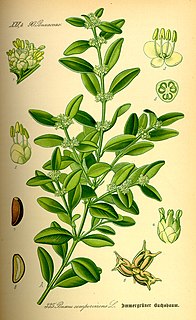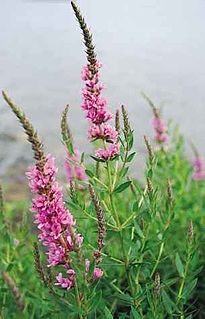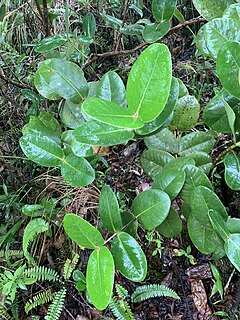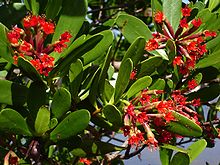
Hamamelidales is an order of flowering plants formerly accepted in a number of systems of plant taxonomy, including the Cronquist system published in 1968 and 1988. The order is not currently accepted in the Angiosperm Phylogeny Group III system of plant taxonomy, the most widely accepted system as molecular systematic studies have suggested that these families are not closely related to each other. The APG II system (2003) assigns them to several different orders: Hamamelidaceae and Cercidiphyllaceae to Saxifragales, Eupteleaceae to Ranunculales, Platanaceae to Proteales, and Myrothamnaceae to Gunnerales. Additional studies of the chloroplast genome have since confirmed that the families moved into the Saxigragales are closely related.
The Cronquist system is a taxonomic classification system of flowering plants. It was developed by Arthur Cronquist in a series of monographs and texts, including The Evolution and Classification of Flowering Plants and An Integrated System of Classification of Flowering Plants (1981).

Austrobaileyales is an order of flowering plants consisting of about 100 species of woody plants growing as trees, shrubs and lianas. The best-known species is Illicium verum, commonly known as star anise. The order belongs to the group of basal angiosperms, the ANA grade, which diverged earlier from the remaining flowering plants. Austrobaileyales is sister to all remaining extant angiosperms outside the ANA grade.

Geraniales is a small order of flowering plants, included within the rosid subclade of eudicots. The largest family in the order is Geraniaceae with over 800 species. In addition, the order includes the smaller Francoaceae with about 40 species. Most Geraniales are herbaceous, but there are also shrubs and small trees.

The Zygophyllales are an order of dicotyledonous plants, comprising the following two families:

The Buxales are a small order of eudicot flowering plants, recognized by the APG IV system of 2016. The order includes the family Buxaceae; the families Didymelaceae and Haptanthaceae may also be recognized or may be included in the Buxaceae. Many members of the order are evergreen shrubs or trees, although some are herbaceous perennials. They have separate "male" (staminate) and "female" (carpellate) flowers, mostly on the same plant. Some species are of economic importance either for the wood they produce or as ornamental plants.

Lythraceae is a family of flowering plants, including 32 genera, with about 620 species of herbs, shrubs, and trees. The larger genera include Cuphea, Lagerstroemia (56), Nesaea (50), Rotala (45), and Lythrum (35). It also includes the pomegranate and the water caltrop. Lythraceae has a worldwide distribution, with most species in the tropics, but ranging into temperate climate regions as well.

Olinia is a genus of small trees and shrubs with 10 species in the family Penaeaceae. The species of Olinia are native to Africa, ranging from west Africa to South Africa. It was previously regarded as the sole genus in the family Oliniaceae, but is now included in the expanded Penaeaceae along with Rhynchocalyx under the APG III system of classification.

Rhynchocalyx lawsonioides is a small flowering tree, the sole species of the genus Rhynchocalyx. It had also previously been regarded as the only species in the monogeneric family Rhynchocalycaceae but is now included in the expanded Penaeaceae along with Olinia under the APG III system of classification. Rhynchocalyx is endemic to the KwaZulu-Cape coastal forest mosaic ecoregion of the Natal and Eastern Cape provinces of South Africa.

The Penaeaceae are a family of evergreen, leathery-leaved shrubs and small trees, native to South Africa. The family has 29 species in 9 genera. The family Penaeaceae was expanded under the APG III system of classification with the inclusion of the genera Olinia and the single species from the genus Rhynchocalyx.

Alzatea verticillata is a small flowering tree, native to the Neotropics. It inhabits moist submontane forests from Costa Rica and Panama in Central America south to Peru and Bolivia in tropical South America. It is the sole species of genus Alzatea and family Alzateaceae.

The Crypteroniaceae are a family of flowering trees and shrubs. The family includes 13 species in three genera, native to Indomalaya.

The rosids are members of a large clade of flowering plants, containing about 70,000 species, more than a quarter of all angiosperms.
The APG system of plant classification is the first version of a modern, mostly molecular-based, system of plant taxonomy. Published in 1998 by the Angiosperm Phylogeny Group, it was replaced by the improved APG II in 2003, APG III system in 2009 and APG IV system in 2016.
The APG II system of plant classification is the second, now obsolete, version of a modern, mostly molecular-based, system of plant taxonomy that was published in April 2003 by the Angiosperm Phylogeny Group. It was a revision of the first APG system, published in 1998, and was superseded in 2009 by a further revision, the APG III system.
A system of plant taxonomy, the Goldberg system was published in:
A system of plant taxonomy, the Bessey system was published by Charles Bessey in 1915.
The APG III system of flowering plant classification is the third version of a modern, mostly molecular-based, system of plant taxonomy being developed by the Angiosperm Phylogeny Group (APG). Published in 2009, it was superseded in 2016 by a further revision, the APG IV system.
The APG IV system of flowering plant classification is the fourth version of a modern, mostly molecular-based, system of plant taxonomy for flowering plants (angiosperms) being developed by the Angiosperm Phylogeny Group (APG). It was published in 2016, seven years after its predecessor the APG III system was published in 2009, and 18 years after the first APG system was published in 1998. In 2009, a linear arrangement of the system was published separately; the APG IV paper includes such an arrangement, cross-referenced to the 2009 one.













